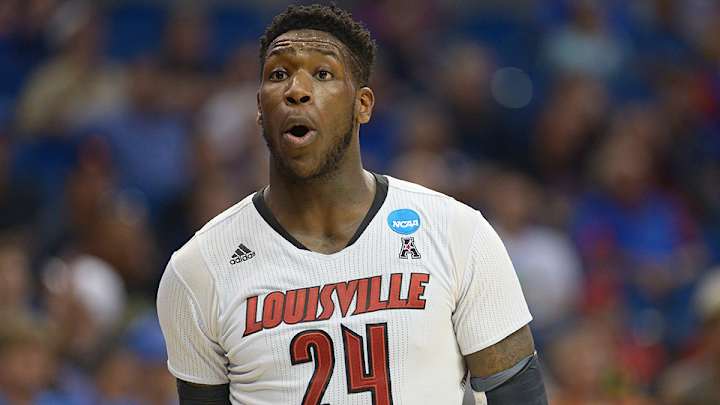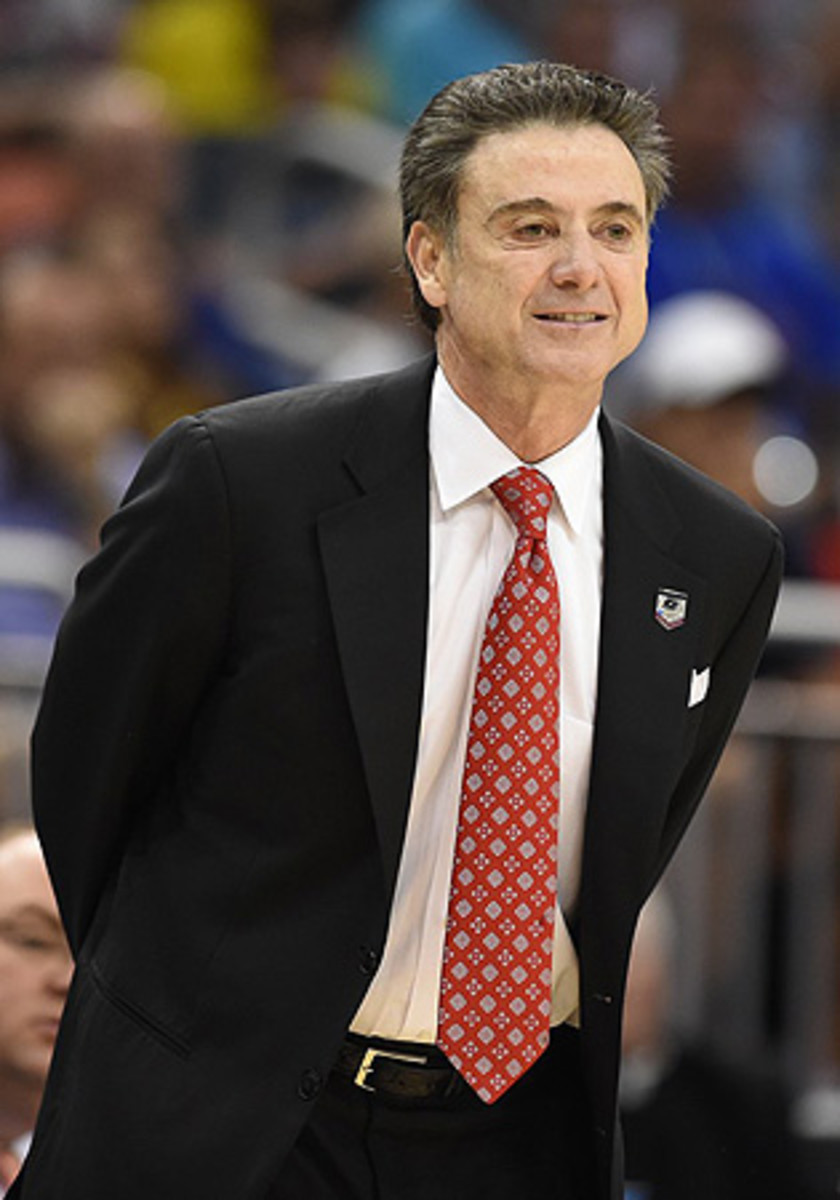Montrezl Harrell's mission: Guiding Louisville into the ACC's elite in Year 1

LOUISVILLE, Ky. – Montrezl Harrell shows up early in the Yum! Center practice facility lobby, because he has a commitment later that afternoon. He has to save the president.
He and a few other students are meeting to hone their plan to save Dr. James Ramsey, who has run Louisville since 2002. It’s a project for a communication class, a short film due at the end of the semester. Harrell and others play members of campus security. They receive a call threatening the school president. They must race over to the office and stop the would-be assassin, who will make an attempt on Ramsey’s life by throwing a basketball at his head.
In the climactic scene – uh, spoiler alert? – Harrell blocks the shot.
“It’s something different,” Harrell says. “It’s a funny thing the president would get into, and he’s up for it. So I feel like it’ll be pretty good.”
College basketball conference previews: ACC
Being counted on to save the day in an ominous, high-stakes situation is no side project. Consider it the role of Harrell’s life. As a freshman in Louisville 2013 national title run, he was a role player. He and the Cardinals followed that up last year in the AAC with a league title and a No. 4 seed in the NCAAs. This season, Louisville basketball debuts in the ACC, and that same 6-foot-8, 240-pound junior forward from North Carolina is its primary survival tool. Harrell took very little time contemplating an NBA future last spring before announcing his return to the Cardinals. Now it’s largely up to him to ensure there will be no death by basketball this year, for anyone.
“I was thinking the other day watching practice, without Montrezl Harrell, we may not win five games with this type of schedule,” Louisville coach Rick Pitino pronounced at ACC media day this week. “It's euphoric to have him suiting up again this year.”
Harrell diligently built an arsenal deeper than dunks and put-backs and effort scores that have been the staple of his game to date. In the offseason, he hoisted hundreds of jumpers a day, from the mid-range back to the three-point stripe. He averaged 14 points and 8.4 rebounds as a sophomore while shooting 60.9 percent, and if he maintains that efficiency with an expanded repertoire, it should boost his All-America candidacy and keep Louisville in the ACC title conversation. “You can’t teach motor,” Cardinals assistant Wyking Jones says. “I expect him to be one of the top players in the country and for an NBA team to really want him to be part of their organization, because he has that intangible. He’s a winner, he competes, he has a high motor, and now he’s added some things to his game that translates to him being very versatile.”
• WINN & HANNER: Projecting the top 100 scorers in college basketball
Harrell knew what wasn’t there, which was the primary reason he stayed here, on a college campus, for at least one more season. Early in April, he absorbed counsel from his family and from Pitino and retreated to his dorm room to contemplate it all alone. He concluded his game wasn’t well-rounded enough, and he wasn’t ready to treat basketball as big business. “If the (NBA) coaches feel like you can’t get the job done, then they bring in somebody else to do it,” Harrell says. “They send you down to the developmental league. Those are places I never want to be as a player.” When he settled on the decision to return for 2014-15, “everything just felt right,” Harrell says.

When that weight trickled off his shoulders, it left plenty of room for other burdens. Louisville’s coaches put improvements in free-throw shooting and defensive rebounding atop Harrell’s to-do list. He shot just 46.4 percent from the line as a sophomore, and the staff showed him how even a mere 15 to 20 percent increase would add another two or three points every game. “Which is huge,” Jones says. Likewise, Harrell’s defensive rebounding percentage jumped from 14.6 as a freshman to 19.7 as a sophomore, but the national leaders exceeded 30 percent efficiency there. The pride in his offensive glasswork – his 120 boards on that end ranked 13th nationally last season – had to translate to the defensive side.
Still, with the loss of outlets like Russ Smith (18.2 points per game) and Luke Hancock (12.3), and with just one other double-digit scorer returning in senior guard Chris Jones, Harrell had to be more expansive with his offensive outlook. So after individual skill work during the day, and then maybe a nap, he’d regularly return to the practice facility around 10:30 or 11 p.m. “I don’t really sleep too much in the night anyway,” Harrell says. “If I’m up at that time, I’m going to go to the gym and make sure I’m doing something productive.” One of his standard workouts routines involved getting on the shooting gun and fired 200 to 300 shots from various locations on one side of the floor, from 15 feet and beyond. He’d repeat the actions from those earlier skill sessions, ripping left, ripping right, taking two dribbles into a pull-up jumper.
For what it's worth, his coaches believe his progress in practice has been evident: He was 6-of-11 from three-point range in Louisville’s first two scrimmages before a 1-for-7 dip in the third. He hit 15 of 23 (65%) free throws over the trio of intrasquad exhibitions. Essentially, Harrell’s enhanced range enhances Pitino’s options; for example, Harrell now can contribute comfortably at small forward, should Louisville want to go big. “The thing he does the best is one-dribble pull-ups – he’s really, really good at that from 15 to 16 feet,” Jones says. “But at the same time, he still goes down and gets offensive rebounds and dunks and posts up hard.”
It’s no wonder Harrell is willing to address shortcomings in his game – he’s hard-wired with good awareness. Jones notes how Harrell corrects himself during plays; he’ll say he should have been in a given spot and executed a given job before the coaches can chime in. During scouting sessions, Harrell “knows as well as anybody else we have what it is he’s supposed to be doing,” per Jones. And the preseason All-ACC pick also boasts a very practical self-conscious streak. Semi-regularly, but especially after a workout he suspects was subpar, Harrell will approach Pitino with a question or five. How do you think I practiced? What do you think I did wrong? What can I work on? “They see your mistakes,” Harrell says of his coaches. “We’re out here playing, we feel like we’re not really making any mistakes, but no, they’re watching it. It’s just going to make me better.”
New ACC coaches ready for challenge of 'best league not in the NBA'
The mindfulness extends into Louisville’s maiden ACC voyage. Harrell is from Tarboro, N.C., a town about an hour east of the league’s Tobacco Road mainstays. He grew up a North Carolina fan, and he loves that Louisville’s schedule now features trips to his home state instead of outposts like DePaul (in the Big East) or South Florida (in the Big East and AAC), so his family can see him play more often. “It’s crazy,” Harrell says, “because I’m back in the ACC, where I always wanted to be.” He knows the craziness, though, extends to the competition level. Four ACC teams, the Cardinals included, populated the preseason coaches’ top 10. Louisville will rely on youth to provide quality minutes off the bench, and he intends to make sure the newcomers know what they are getting into.
“Once the schedule came out, I was telling them, now y’all see what lies ahead of us,” Harrell says. “Everybody’s been talking about it, everybody’s saying we were ready to get into the ACC. Now you see, you feel me? Our schedule is really out. All the games are out. There’s no running from it.”
Louisville is confident in its core. There is Harrell. There are veterans like Jones and senior forward Wayne Blackshear. There is promising sophomore guard Terry Rozier, who averaged seven points per game as a freshman and is destined for greatness in the minds of Cardinals’ faithful. What comes after – what Louisville gets from a freshman class featuring four Rivals.com top 100 recruits – remains to be seen. Picking up defensive nuances, for one, has been a work in progress; Pitino used actual tape last week to mark off a box on the floor, hoping it would help the younger players better visualize proper help-defense positioning.
• MORE CBB: Read all of SI.com's preseason coverage
Harrell believes no opponent will push the newbies harder than their teammates and coaches, so it all will fall into place. It’s not unlike that class project of his, in fact, which has begun filming but still is in need of a location for the save-the-President scene. The group came to the conclusion that throwing a basketball around an actual president’s office, and likely breaking things, was a bad idea. There is much to be determined, but everything seems on track.
“It’s one of those things that’s building up,” Harrell says, though soon enough it’ll be time to jump in and take matters into his own hands.
